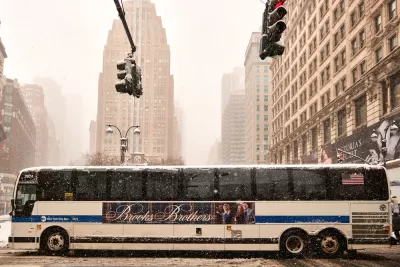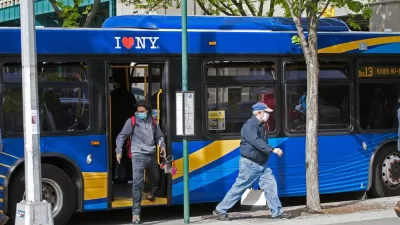A new report cites decreased ridership and dismal service despite a growing need for more and better routes.

Very few who have tried to ride a New York City bus will be surprised by the comptroller’s deeply critical report on the system. From The New York Times:
"Though New York City’s buses carry over two million passengers a day — more than the Long Island Rail Road, Metro-North, PATH and New Jersey Transit combined — they are often treated as an afterthought, even as they hemorrhage riders and strand the mostly low-income New Yorkers who depend on them, according to a report released on Monday by the city comptroller’s office."
This is not exactly news. Though expanding bus service is relatively inexpensive, it is decidedly un-glamorous, meaning that more often than not city officials end up pushing either an expensive subway project that may take a century to complete, or more recently a waterfront streetcar line.
The subway system is having its own crisis, the Times recently reported at length, but that has received more attention than the longstanding problem with buses. The comptroller’s report attributes that disparity in part to the inequity between subway and bus riders.
“[W]hen the buses run late, or barely run at all, those affected are often from low-income, minority or immigrant communities, the report says. The average personal income of bus commuters is $28,455, compared with $40,000 for subway commuters, the comptroller’s report says. More than half of bus commuters are foreign-born, and only 25 percent are white.”
Despite the fact that ridership is down, the need for city bus service is up, as the number of people and jobs in boroughs other than Manhattan have grown dramatically in recent years.
Ambitious plans for the bus lines historically fail to take priority, so even though mayor’s administration points out that it has “committed $270 million to Select Bus Service and had announced plans last month to add 21 of the express routes over the next decade,” the question that remains is whether or not the city will deliver.
FULL STORY: Bus Service Is in Crisis, City Comptroller’s Report Says

Alabama: Trump Terminates Settlements for Black Communities Harmed By Raw Sewage
Trump deemed the landmark civil rights agreement “illegal DEI and environmental justice policy.”

Planetizen Federal Action Tracker
A weekly monitor of how Trump’s orders and actions are impacting planners and planning in America.

Why Should We Subsidize Public Transportation?
Many public transit agencies face financial stress due to rising costs, declining fare revenue, and declining subsidies. Transit advocates must provide a strong business case for increasing public transit funding.

Understanding Road Diets
An explainer from Momentum highlights the advantages of reducing vehicle lanes in favor of more bike, transit, and pedestrian infrastructure.

New California Law Regulates Warehouse Pollution
A new law tightens building and emissions regulations for large distribution warehouses to mitigate air pollution and traffic in surrounding communities.

Phoenix Announces Opening Date for Light Rail Extension
The South Central extension will connect South Phoenix to downtown and other major hubs starting on June 7.
Urban Design for Planners 1: Software Tools
This six-course series explores essential urban design concepts using open source software and equips planners with the tools they need to participate fully in the urban design process.
Planning for Universal Design
Learn the tools for implementing Universal Design in planning regulations.
Caltrans
Smith Gee Studio
Institute for Housing and Urban Development Studies (IHS)
City of Grandview
Harvard GSD Executive Education
Toledo-Lucas County Plan Commissions
Salt Lake City
NYU Wagner Graduate School of Public Service




























